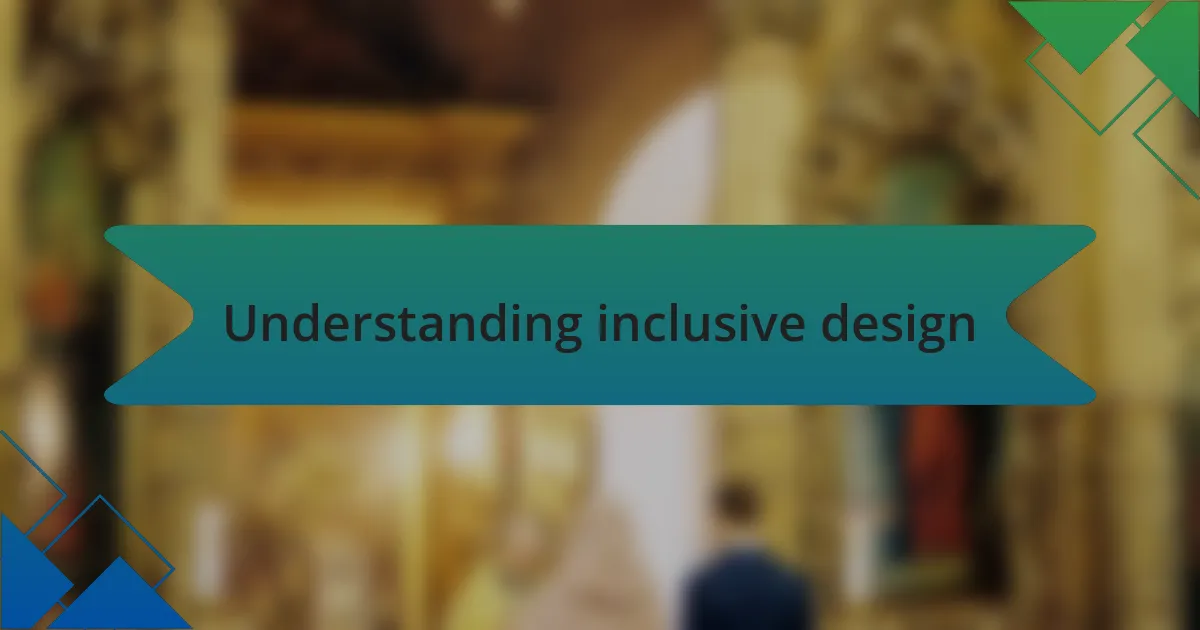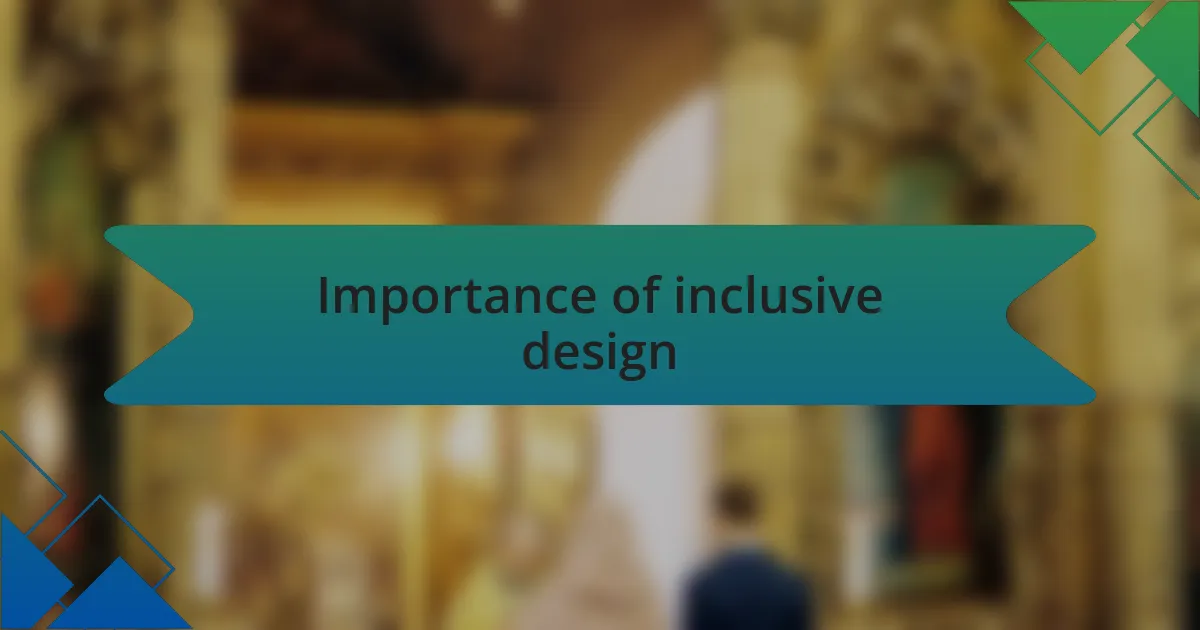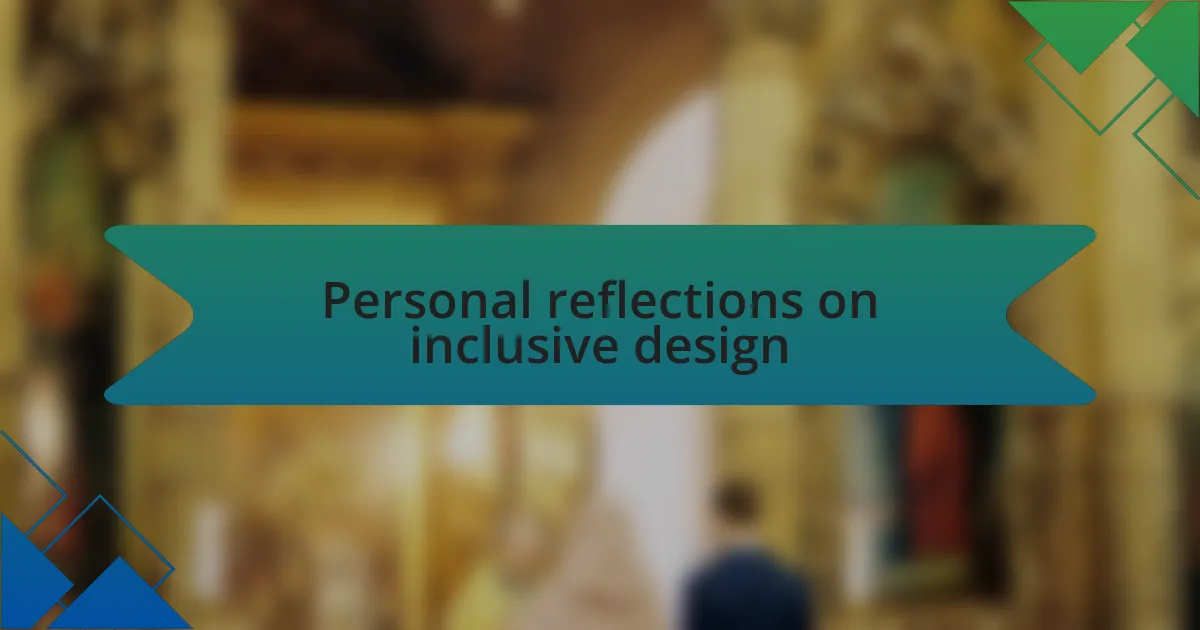Key takeaways:
- Inclusive design enhances user experience by considering diverse needs, fostering empathy and creativity.
- Implementing inclusive features, like larger buttons and screen reader compatibility, benefits all users, improving engagement and accessibility.
- Social media icons are crucial for navigation and brand recognition; their design must be inclusive to accommodate users with disabilities.
- Personal experiences in inclusive design lead to deeper understanding of user interactions and the importance of thoughtful, empathetic design choices.

Understanding inclusive design
Inclusive design is all about creating experiences that everyone can enjoy, regardless of their abilities or circumstances. I remember a time when I struggled to use a website that lacked proper contrast in its colors. It wasn’t just about aesthetics; it impacted my ability to navigate and find what I needed. Have you ever felt that frustration when a simple task becomes a chore due to design oversight?
When I think about inclusive design, I visualize a spectrum of users, each with unique needs. This perspective encourages me to ask, “How can I ensure my work is accessible to all?” It’s crucial to consider features like keyboard navigation or screen reader compatibility. These aren’t just technical adjustments; they’re thoughtful gestures that make digital spaces welcoming.
Embracing inclusive design isn’t merely about compliance; it’s about empathy. I’ve found that when I prioritize accessibility in my projects, it often leads to more creative solutions. Isn’t it exciting to think that by acknowledging diverse needs, we can not only enhance usability but also enrich our designs?

Importance of inclusive design
Inclusive design is essential because it ensures that digital spaces cater to everyone, including those with disabilities. I once had a colleague who had difficulty using a trackpad due to a motor impairment. We modified our website, adding larger click areas and ensuring touch responsiveness, which not only improved their experience but also made it more user-friendly for everyone. Doesn’t it feel rewarding to create an environment where nobody is left behind?
Relying on inclusive design principles often leads to unexpected benefits, like increased engagement and broader reach. While working on a recent social media campaign, I learned that adjusting our content to be compatible with screen readers not only helped visually impaired users but also improved overall readability for everyone. Have you discovered that small changes can have profound impacts, even beyond the initially intended audience?
Moreover, when we prioritize inclusivity, we cultivate a culture of belonging. I’ve seen firsthand how a design that welcomes diverse users fosters stronger connections among audiences. It’s a bittersweet realization that many online spaces still fall short, but every effort toward inclusivity can spark change. How can we take those steps together to create a more inclusive digital world?
![]()
Overview of social media icons
Social media icons are ubiquitous elements in digital design, serving as gateways to connect users with their favorite platforms. I remember the first time I encountered a social media icon that was non-functional; it left me frustrated, highlighting how crucial these icons are for smooth navigation. Have you ever clicked on an icon only to find it leads nowhere? It’s a hiccup that can deter users from engaging more deeply.
These icons aren’t just decorative; they’re essential for brand recognition and user interaction. Each platform, from Facebook to Twitter, has a distinct icon design that fosters familiarity and trust. I once worked on a project where consistent use of social media icons directly influenced our audience’s willingness to connect with us online. It struck me how something so simple could make such a significant impact on user behavior.
Inclusivity in social media icons matters just as much as their design. For example, ensuring that these icons are easily discernible for color-blind users can enhance accessibility for a broader audience. I recall implementing high-contrast versions of icons on a website, which made a noticeable difference in user engagement. Isn’t it paramount that our digital tools serve everyone effectively?

Personal reflections on inclusive design
Reflecting on inclusive design, I often think about the little things that can make a world of difference. For instance, when I revisited a site that had implemented descriptive text alongside their social media icons, I felt instantly more connected. It was more than just aesthetic; it made the whole experience feel more welcoming. How often do we overlook the power of words in design?
I vividly remember a time when I assisted a friend with a website for their small business. We decided to introduce larger, simpler social media icons to cater to older users who might struggle with smaller graphics. The joy on my friend’s face when their family members began using the site more often was priceless. This experience reinforced my belief that inclusive design isn’t just about compliance; it’s about empathy and understanding the diverse needs of our audience.
In my journey, I realized that the process of creating inclusive designs often reveals profound insights about human interaction. Each time I engage with users who have disabilities, their feedback transforms my perspective. I once learned that a visually appealing icon is meaningless if it alienates someone who can’t perceive it as intended. Why wouldn’t we strive to ensure that everyone can navigate our digital spaces comfortably?